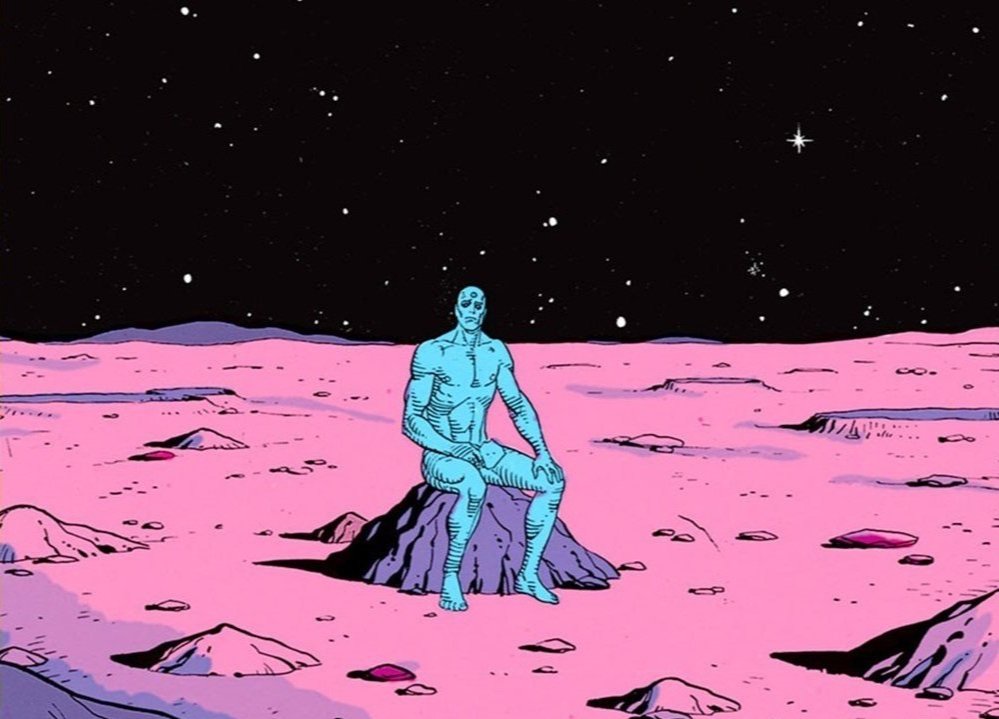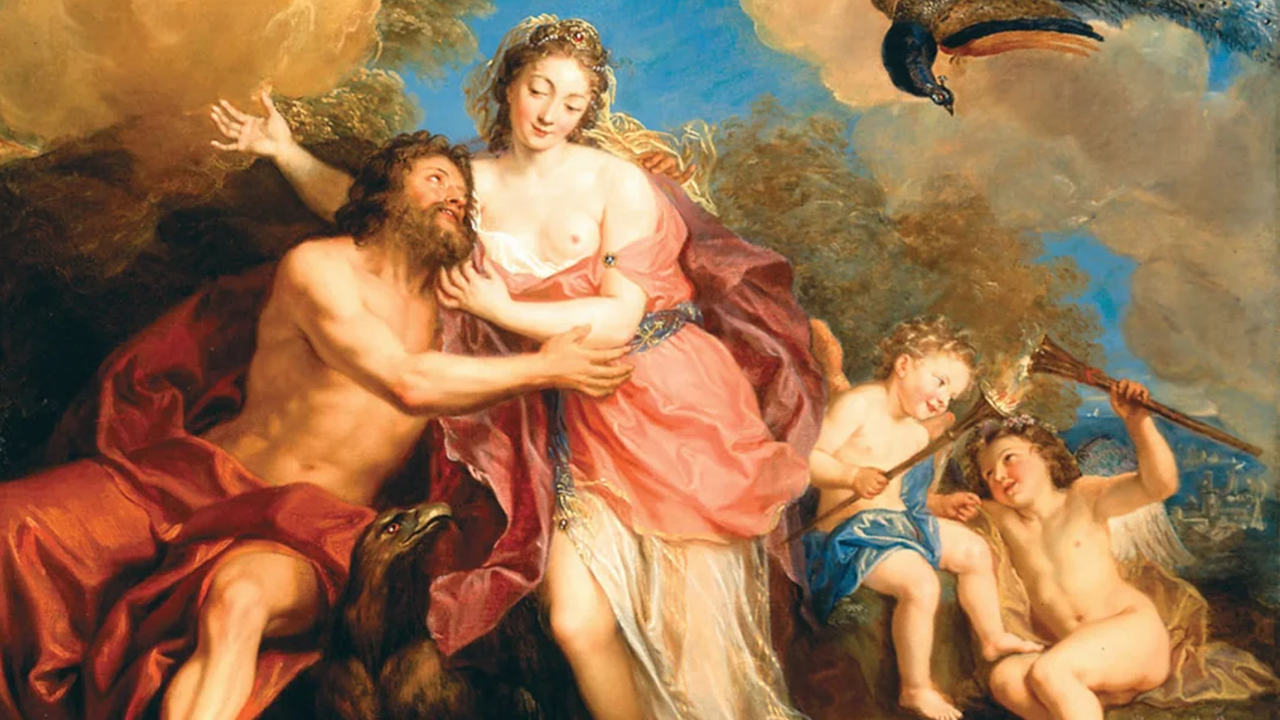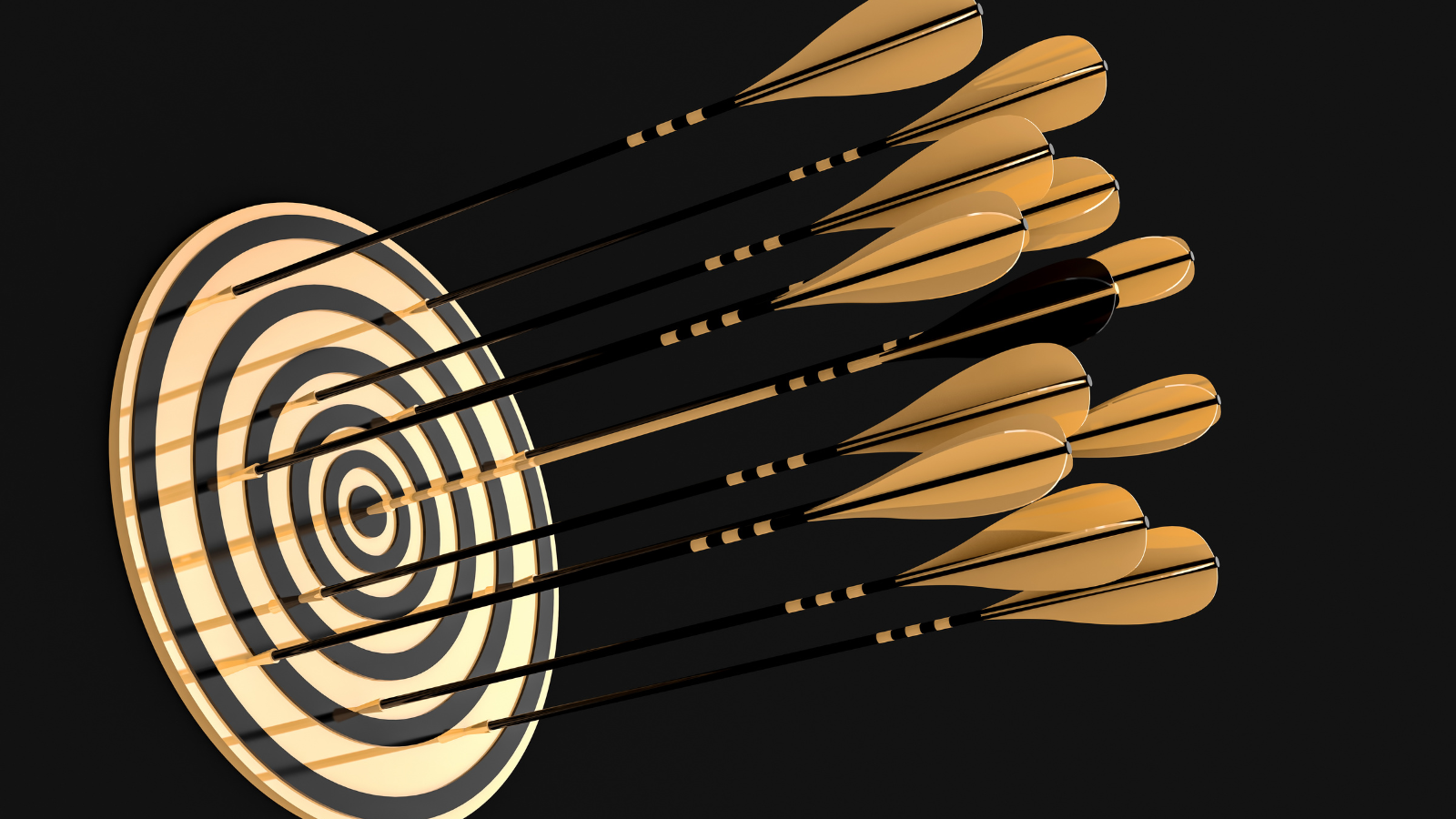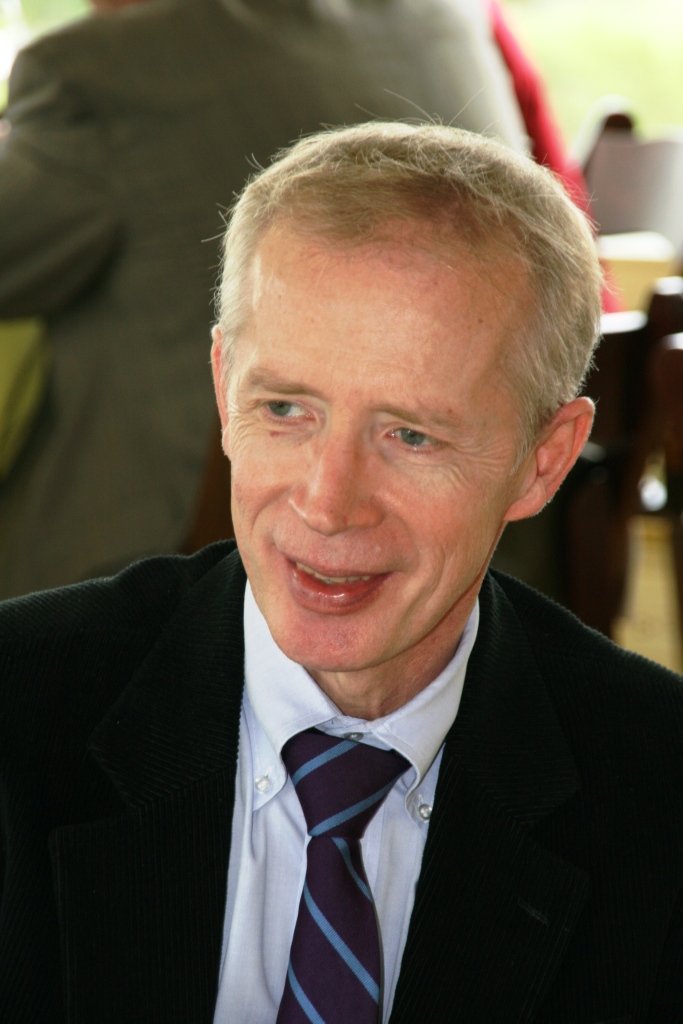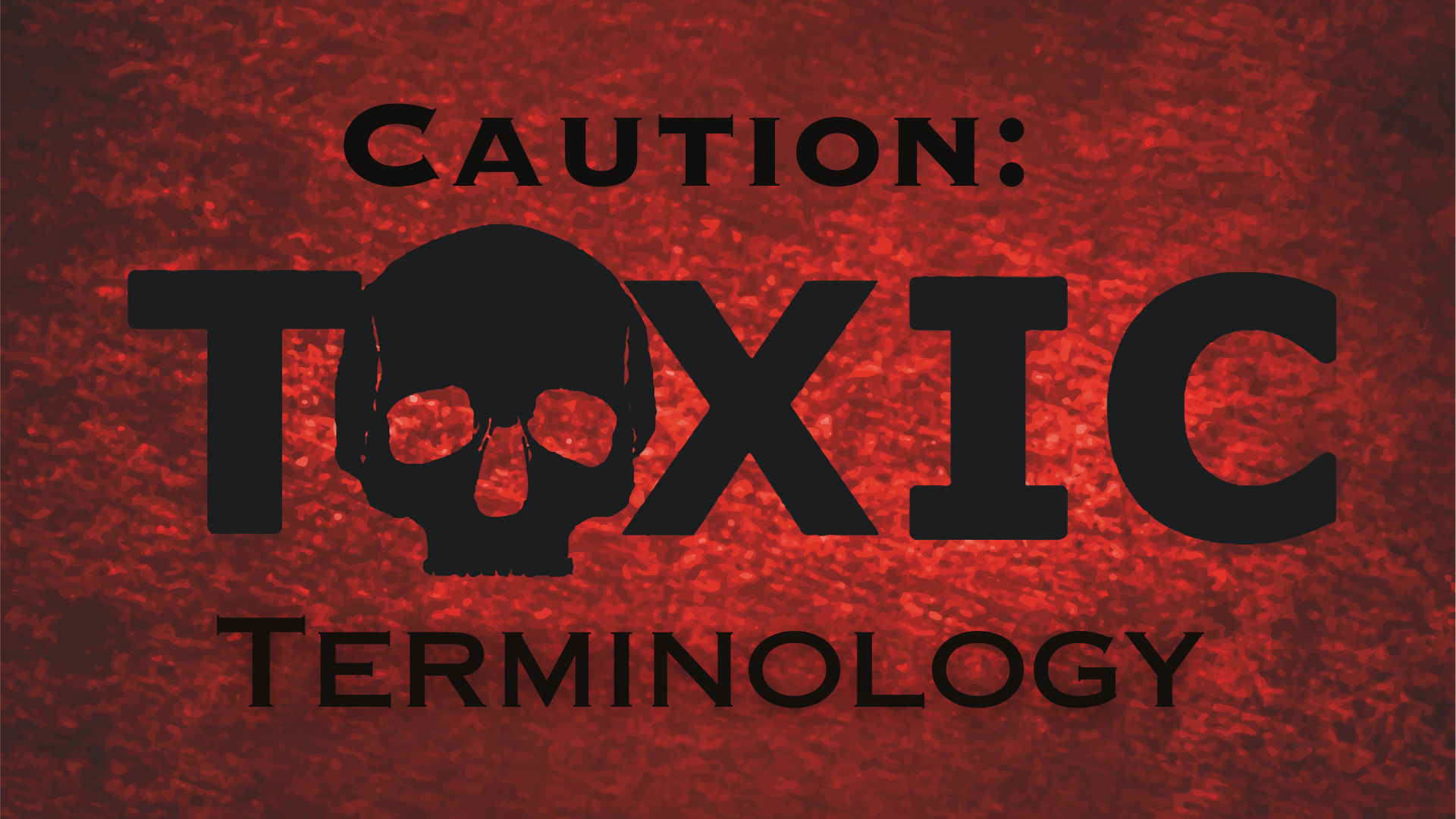Who watches the Watchmen, and who constructs the constructions? Superheroes, ideology and masculinity.
Picture: Dr Manhattan, one of the Watchmen, contemplating his purpose on Earth.
If you think superhero comics are for kids – think again. The Watchmen series brings superheroes out of the realm of make believe and into the real world of “sexual neuroses, bad breath and anxiety disorders”. Not only do these stories offer a metaphor explaining what is happening with masculinity today, but they don’t have to be understood in the context of trendy theories of postmodernism.
Alan Moore’s Watchmen series is set in a dark, dystopian version of New York in the 1980s, filled with post-Vietnam demoralisation, post-Watergate cynicism and Cold War paranoia. Where in previous years superheroes were looked up to as saviours, they are now outlawed as vigilantes. Against this backdrop, the series starts with how a network of aging superheroes – The Watchmen - are shocked by the brutal murder of one of their key members. In trying to find out who is to blame, they uncover a terrifying conspiracy to construct world unity by engineering a nuclear war between the US and Soviet Union. Lurking in the background of the story is the sense that ordinary people have lost trust in their protectors, and the question ‘who watches the Watchmen?’ is never far from the surface.
This article will begin by outlining some of the social constructionist views of superheroes - which tend to be rather cynical about masculinity - and go on to consider superheroes in the context of what we know about the science of masculinity.
The construction of masculinity
Warriors have worn armour throughout history, both for protection and to appear fearsome to the enemy. Arguably, there is a similar power in putting on a superhero costume in the construction of heroic masculinity in Watchmen. The changing of costume, then, is the mechanism by which the apparent split between heroic and everyday masculinity is resolved. Social construction theorists argue that the superhero’s mask constructs identity rather than expressing an already inherent aspect of identity.
“Although the social constructionist claims about masculinity make a certain amount of sense, it would be a mistake to accept them uncritically as a full explanation of masculinity.”
Some social constructionists suggest that the superhero costume is a symbol of constructed or ‘performative’ identity, and that Watchmen deals with masculine anxiety and identity crises: heroes are simply normal men performing masculinity. Although the performance leads to violence and conflict, without this performance the superhero is overwhelmed by a sense of the mundane. An example of this is suggested to be the loss of masculine potency when the character Night Owl cannot perform sexually unless he is wearing his superhero costume.
Critique of the critique
Although the social constructionist claims about masculinity make a certain amount of sense, it would be a mistake to accept them uncritically as a full explanation of masculinity. Firstly, it is somewhat unclear as to whether their analysis applies to real-world masculinity, or only to the fictitious form found in the superhero genre. It is, however, evident that they view both superhero and real-world masculinity as something constructed, with no influence of biology or evolution.
Picture: Rorschach, one of the Watchmen
The a priori assumption that masculinity is socially constructed leads authors to try to deconstruct it, based upon the belief that it can be deconstructed.
Authors taking the social constructionist view ignore – perhaps conveniently for their theory - evidence that biological, hormonal, and evolutionary factors play a role in determining gender identity and behaviour. Thus, social constructionist attempts at deconstruction ignore elements of the heroic tendency which may speak to an instinctual aspect of masculine identity. The hero as a psychological archetype may not be so easy to deconstruct if archetypal expressions are “psychical correspondents of human instincts” or if the heroic tendency is “a central and permanent aspect of human being”.
The above explanation for Night Owl’s impotence leaves out an important dimension. It’s not just that he can only perform when wearing his costume, his lover, Laurie, also can get sexual satisfaction when he wears his costume. This hints at the role femininity plays in encouraging and desiring typically masculine traits, and the impact of female sexual selectivity on human relationships.
Social contructionists make multiple claims that the superhero has no inherent identity, yet also that the superhero masquerade is “not an anarchic loss of identity but an active stand against chaos”. This allows transformation of the hero into a figure who protects from evil forces. This latter claim is, ironically, in line with an evolutionary view that the mythological hero embodies a protective force for the tribe. He is “the knight who slays the dragon of chaos, the hero who replaces disorder and confusion with clarity and certainty”. Social constructionists like Weltzien acknowledge that by doing so, the hero enters into a “domain of abstract morality. […] The change of costume […] presents conflict as […] a spiritual, even theological, collision between good and evil”.
“Reviewing the academic analyses of Watchmen is an exercise in reviewing ideologically driven texts describing an ideologically driven text.”
The character of the superhero is indeed perpetually engaged in moral struggle. This fulfills a spiritual need, in secular language, for the ability to identify with the good. In opposition to claims of dehumanisation, the superheroes’ beyond-human (and hyper-masculine) abilities are not something which severs them from humanity, but which enables them to fight for it.
Reviewing the academic analyses of Watchmen is an exercise in reviewing ideologically driven texts describing an ideologically driven text. It is clear that Alan Moore’s intention was to deconstruct the superhero genre, specifically in regards to authoritarian and ideological power. This is rightly addressed and reflected by social constructionist authors. Yet – perhaps inevitably – these analyses are often through the lens of their own ideological biases, blinding them to other relevant factors. It might even be true to say that no matter how well-intentioned left-wing radicalism may be, it can lead to the totalitarian mindset that Moore wanted to subvert. Can ideology be successfully subverted through the medium of comics? If comics can only uphold the ‘status quo’, then any attempt to subvert it is, in essence, futile.
The social constructionist literature on identity in Watchmen seems to slide inevitably towards an attack on real-world masculinity, and ignores crucial evidence that masculine identity is partly innate. Some authors give the impression that expressions of masculine strength and power - no matter how benevolent - will be relentlessly belittled by feminist thinkers despite their aspirations of ‘gender equality’. They define heroic masculinity as primarily negative, ignoring any positive aspects. They then impose their own standard for what the positive should be which is, circularly, based on their analysis of masculinity as primarily negative.
Picture: The Watchmen: (L-R) The Comedian, The Silk Spectre, Dr Manhattan, Ozymandias, Night Owl, Rorschach.
This is nothing new – feminist theory so often views real-world maleness in this way. While offering some valid critique of how gendered expectations may hurt men, theorists seldom acknowledge the contribution that masculinity and male strength have made to the building and maintaining of society. In their application of feminist theory to Watchmen, this vital aspect of masculinity remains unaddressed. That the superhero genre, and in turn the heroic tendency, may be reflective of this valid and evolved aspect of humanity, is unaddressed also. One wonders how the tone of condescension taken in these texts impacts the main demographic of comic readers - i.e. adolescent males.
Final thoughts
As Jamie Hughes suggested: no matter how hard we try to get outside of our ideologies, they still watch over us. And this leads us back to the question that is just as important of academics as it is of superheroes: Who Watches the Watchmen? We might add a question of our own: who constructs the constructions?
Scroll down to join the discussion
Disclaimer: This article is for information purposes only and is not a substitute for therapy, legal advice, or other professional opinion. Never disregard such advice because of this article or anything else you have read from the Centre for Male Psychology. The views expressed here do not necessarily reflect those of, or are endorsed by, The Centre for Male Psychology, and we cannot be held responsible for these views. Read our full disclaimer here.
Like our articles?
Click here to subscribe to our FREE newsletter and be first
to hear about news, events, and publications.
Have you got something to say?
Check out our submissions page to find out how to write for us.
.


